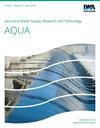过渡段形状对底部出口空化特性的影响
IF 4.3
Q2 Environmental Science
引用次数: 0
摘要
底出口闸室段的水力特性比较复杂。特别是,当隧道内的流动从加压状态过渡到非加压状态时,空化是一个突出的问题。作为对策,通常在加压段的末端安装侧壁收缩器。本文通过数值模拟和真空罐实验,分析了几种原型方案的设计参数,研究了过渡段的流动特性和空化特性。影响空化风险的四个主要因素是过渡段收缩比、顶压坡度、过渡段长度和孔口形状。实际工程研究表明,通过施加较大的收缩度,可以减缓顶压坡,延长加压过渡段,从而降低空化风险,改善流态。研究结果可为水工建筑物的优化设计提供参考。本文章由计算机程序翻译,如有差异,请以英文原文为准。
Influence of the transition section shape on the cavitation characteristics at the bottom outlet
The hydraulic characteristics of the lock chamber section in a bottom outlet are complex. Particularly, cavitation is a prominent problem when the flow in the tunnel transitions from pressurized to unpressurized conditions. As a countermeasure, sidewall contractions are often installed at the end of the pressurized section. In this paper, with numerical simulations and vacuum tank experiments, we analyzed the design parameters of several prototype projects and studied the flow properties and cavitation characteristics of the transition section. The four main factors that influence cavitation risks are the contraction ratio of the transition section, the top press slope, the length of the transition section, and the shape of the orifice. The study of a real-world project demonstrates that by implementing a severe constriction degree, the top press slope can be slowed down, and the pressurized transition section can be extended, thereby reducing cavitation risks and improving flow patterns. These research results provide a reference for the optimal design of hydraulic structures.
求助全文
通过发布文献求助,成功后即可免费获取论文全文。
去求助
来源期刊
CiteScore
4.70
自引率
0.00%
发文量
74
审稿时长
4.5 months
期刊介绍:
Journal of Water Supply: Research and Technology - Aqua publishes peer-reviewed scientific & technical, review, and practical/ operational papers dealing with research and development in water supply technology and management, including economics, training and public relations on a national and international level.

 求助内容:
求助内容: 应助结果提醒方式:
应助结果提醒方式:


